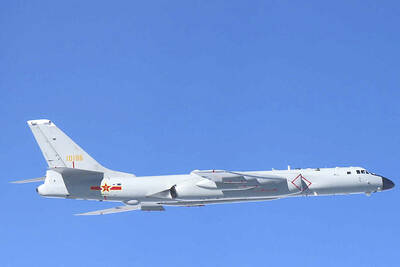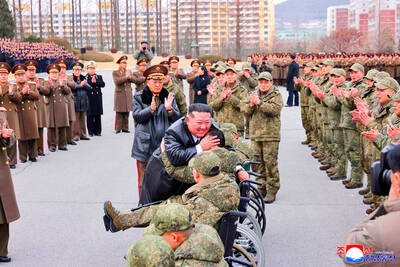The US began planning a full-scale military campaign against Iran that involves missile strikes, a land invasion and a naval operation to establish control over the Strait of Hormuz even before the March 2003 invasion of Iraq, a former US intelligence analyst disclosed yesterday.
William Arkin, who served as the US Army's top intelligence mind on West Berlin in the 1970s and accurately predicted US military operations against Iraq, said the plan is known in military circles as TIRANNT, an acronym for "Theater Iran Near Term."
It includes a scenario for a land invasion led by the US Marine Corps, a detailed analysis of the Iranian missile force and a global strike plan against any Iranian weapons of mass destruction, Arkin wrote in the Washington Post.
US and British planners have already conducted a Caspian Sea war game as part of these preparations, the scholar said.
"According to military sources close to the planning process, this task was given to Army General John Abizaid, now commander of CENTCOM, in 2002," Arkin wrote, referring to the Florida-based US Central Command.
Preparations under TIRANNT began in earnest in May 2003 and never stopped, he said. The plan has since been updated using information collected in Iraq.
Air Force planners have modeled attacks against Iranian air defenses, while Navy planners have evaluated coastal targets and drawn up scenarios for keeping control of the Strait of Hormuz.
A follow-on TIRANNT analysis, which began in October 2003, calculated the results of different scenarios to provide options to commanders, Arkin wrote.
The Marines, meanwhile, have come up with their own document called "Concept of Operations" that explores the possibility of moving forces from ship to shore without establishing a beachhead first.
"Though the Marine Corps enemy is described only as a deeply religious revolutionary country named Karona, it is -- with its Revolutionary Guards, WMD and oil wealth -- unmistakably meant to be Iran," Arkin said.
Various scenarios involving Iran's missile force have also been examined in another study, initiated in 2004 and known as BMD-I, which is short for "Ballistic Missile Defense -- Iran," Arkin said.
In June 2004, US Secretary of Defense Donald Rumsfeld alerted the US Strategic Command in Omaha, Nebraska, to be prepared to implement CONPLAN 8022, a global strike plan that includes Iran, according to Arkin.
"The new task force, sources have told me, mostly worries that if it were called upon to deliver `prompt' global strikes against certain targets in Iran under some emergency circumstances, the president might have to be told that the only option is a nuclear one," Arkin said.
The US military has been involved in contingency planning against Iran since at least the presidency of Jimmy Carter, who undertook a failed commando operation to rescue US hostages in Tehran in 1980.
Following the 1996 bombing of an apartment building used by the US Air Force in Khobar, Saudi Arabia, which was reportedly traced to Iranian agents, the administration of then-president Bill Clinton considered a bombing campaign, according to Richard Clarke and Steven Simon, who held at the time high-level counterterrorism positions at the National Security Council.
"But after long debate, the highest levels of the military could not forecast a way in which things would end favorably for the United States," the two experts wrote in yesterday's New York Times.
They warned Iran could retaliate against the US by using its terrorist networks "that are far superior to anything al-Qaeda was ever able to field."

PARLIAMENT CHAOS: Police forcibly removed Brazilian Deputy Glauber Braga after he called the legislation part of a ‘coup offensive’ and occupied the speaker’s chair Brazil’s lower house of Congress early yesterday approved a bill that could slash former Brazilian president Jair Bolsonaro’s prison sentence for plotting a coup, after efforts by a lawmaker to disrupt the proceedings sparked chaos in parliament. Bolsonaro has been serving a 27-year term since last month after his conviction for a scheme to stop Brazilian President Luiz Inacio Lula da Silva from taking office after the 2022 election. Lawmakers had been discussing a bill that would significantly reduce sentences for several crimes, including attempting a coup d’etat — opening up the prospect that Bolsonaro, 70, could have his sentence cut to

China yesterday held a low-key memorial ceremony for the 1937 Nanjing Massacre, with Chinese President Xi Jinping (習近平) not attending, despite a diplomatic crisis between Beijing and Tokyo over Taiwan. Beijing has raged at Tokyo since Japanese Prime Minister Sanae Takaichi last month said that a hypothetical Chinese attack on Taiwan could trigger a military response from Japan. China and Japan have long sparred over their painful history. China consistently reminds its people of the 1937 Nanjing Massacre, in which it says Japanese troops killed 300,000 people in what was then its capital. A post-World War II Allied tribunal put the death toll

‘UNWAVERING ALLIANCE’: The US Department of State said that China’s actions during military drills with Russia were not conducive to regional peace and stability The US on Tuesday criticized China over alleged radar deployments against Japanese military aircraft during a training exercise last week, while Tokyo and Seoul yesterday scrambled jets after Chinese and Russian military aircraft conducted joint patrols near the two countries. The incidents came after Japanese Prime Minister Sanae Takaichi triggered a dispute with Beijing last month with her remarks on how Tokyo might react to a hypothetical Chinese attack on Taiwan. “China’s actions are not conducive to regional peace and stability,” a US Department of State spokesperson said late on Tuesday, referring to the radar incident. “The US-Japan alliance is stronger and more

FALLEN: The nine soldiers who were killed while carrying out combat and engineering tasks in Russia were given the title of Hero of the Democratic People’s Republic of Korea North Korean leader Kim Jong-un attended a welcoming ceremony for an army engineering unit that had returned home after carrying out duties in Russia, North Korean state media KCNA reported on Saturday. In a speech carried by KCNA, Kim praised officers and soldiers of the 528th Regiment of Engineers of the Korean People’s Army (KPA) for “heroic” conduct and “mass heroism” in fulfilling orders issued by the ruling Workers’ Party of Korea during a 120-day overseas deployment. Video footage released by North Korea showed uniformed soldiers disembarking from an aircraft, Kim hugging a soldier seated in a wheelchair, and soldiers and officials